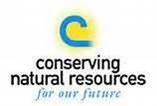
Soil & Water Conservation Fact Sheet
Soil and Water Conservation in Georgia
protecting, conserving, and improving the state's soil and water resources
-
Mission and Vision
Conservation Districts are led by 370 elected and appointed District Supervisors. Along with Georgia Soil and Water Conservation Commission state staff, these local community leaders work in voluntary cooperation with private landowners to encourage the conservation of the state’s natural resources that are the basis of economic growth and prosperity. Aided by the USDA’s Natural Resources Conservation Service, this effort ensures productive lands and healthy ecosystems.
-
Conservation Programs: Healthy Soil and Clean Water Sustain Your Life
Soil Erosion and Certification program provides certification of individuals involved in urban land-disturbing activities, and the Urban Program assists districts with the review and approval of urban land development plans to protect water resources.
small_E&S 2.jpg
Land Disturbance Reviews by GSWCC in partnership with conservation districts to minimize soil erosion through the use of best management practices (BMP). These efforts result in reduced soil erosion and decreased water sedimentation, thus reducing the cost of treating water at municipal filtration plants.
small_Sandy Creek #15.JPGFlood Control Watershed Reservoirs
Dams program protects lives and properties through the operation and maintenance of 357 dams in Georgia.
small_Pond 3.2_pm.jpg
Water Quality Improvement Projects improve the quality of water in targeted areas by the installation of best management practices in agricultural operations to reduce nonpoint source pollution and reduce the costs to downstream municipal water filtration systems.
-
Conservation and Agriculture - Charts
Chart 1. The average age of a farmer in Georgia has risen from 57.8 years in 2007 to 59.9 years in 2012. Conservation districts educate farmers about the many policies, laws, and rules affecting agriculture. (Data Source: 2012 Census of Agriculture)
large_Farmers_ages_0.JPGChart 2. The number of Georgia citizens receiving training in soil and water conservation best management practices from their local Soil and Water Conservation District is growing. (Data Source: GSWCC)
large_Citizens_educated.JPGChart 3. Agriculture remains Georgia's number one industry. Total Farm Gate Value of Commodities in Georgia was $13.9 billion in 2012. (Data Source: University of Georgia)
Ga_Farm_Gate_Value_1.JPGChart 4. The number of agricultural acres in Georgia benefiting from conservation plans is increasing. (Data Source: GSWCC)
Acres_Protected_by_Conservation_0.JPG -
Challenges to Conservation
Challenge to Conservation: Fully Fund the Agricultural Act of 2014. Enacting the Agricultural Act of 2014 was a major victory coming after the expiration of the 2008 Farm Bill, but conservation programs contained in the bill can only be implemented if Congress fully funds the activities required by the legislation.
Under the new law, the Environmental Quality Incentives Program (EQIP), Agricultural Conservation Easement Program (ACEP), and Regional Conservation Partnership Program (RCPP) become the major conservation programs. The Small Watershed Rehabilitation Program is funded through the 2014 Farm Bill.
These programs need to be fully funded at levels that reflect the intent of Congress in the law. With the maximum number of acres allowed under the Conservation Reserve Program declining by 3.5 million acres by fiscal year 2018, it is important that the CRP be fully implemented at the authorized levels. Including the Wildlife Habitat Incentive Program (WHIP) under EQIP makes it vital that EQIP be funded at its full level of $1.65 billion in FY 2015, as mandated by the new law. The conservation programs included in the new law can improve the nation’s natural resources, but only if they are funded at levels that allow full implementation. With the Conservation Stewardship Program (CSP) operating with a reduced annual enrollment cap of 10 million new acres, it is important that CSP be funded to reach its annual cap each year. Congress should remain vigilant to ensure that USDA’s rule-making process adheres to the Congressional intent of the 2014 Farm Bill.
Challenge to Conservation: EPA Regulations. Local Soil and Water Conservation Districts have proven that voluntary cooperation by private landowners has been the most effective approach in conserving and improving water resources in Georgia. Mandatory compliance can be counterproductive.
Defining EPA’s jurisdiction over water. A proposed rule by the U.S. Environmental Protection Agency (EPA) arbitrarily defines the scope of waters protected under the Clean Water Act. If EPA implements this rule, it will obtain regulatory control over virtually all waters, which ignores the intent of Congress in the original legislation. Congress should oppose this rule change and not permit EPA to ignore the will and intent of Congress.
Setting Total Maximum Daily Loads (TMDLs). EPA is seeking authority in the Chesapeake Bay region to set specific water quality standards for industry sectors, as well as setting timelines to meet these detailed allocations. If successful, EPA will have the authority to set their own mandates on industry stakeholders rather than work with local stakeholders within a state.
Setting mandates removes the incentive to work with local stakeholders in improving water quality in locations such as Lake Lanier in Georgia. This contradicts the experience of conservation districts in obtaining voluntary compliance to improve water quality standards.
Challenge to Conservation: Deepening the Port of Savannah. The success of Georgia’s soil and water conservation programs depends on the economic health of the state’s agricultural producers, and many of these producers depend on the Port of Savannah to reach foreign markets. In fact, agricultural exports are the reason Savannah is one of the few ports in the nation with more exports than imports.
The state is ready to make the investment needed to deepen the harbor to accommodate larger vessels, but the federal government has not provided the appropriate authorization or construction funding for the $652 million project and won’t let Georgia jumpstart the project by using its own money.
Investing in the state’s water resources makes sense both for the state as well as for the nation, as the port represents $32.4 billion in state GDP (7.8% of Georgia’s total GDP) and contributes $4.5 billion in federal taxes annually.
The federal roadblock should be removed. Congress needs to provide the federal construction funds needed for the deepening, and either reauthorize the project through the Water Resources Development Act (WRDA) that contains billions of dollars for dam, harbor, and river improvements nationwide; or allow the State of Georgia’s appropriated construction funds to be used to deepen the port while awaiting approval of WRDA.
Challenge to Conservation: GMO Labeling. One of the challenges of the 21st Century is to feed more people using existing water supplies on an ever-shrinking amount of farm land, as urban development squeezes out agricultural land. One solution is to produce crops bred with specific characteristics that require less water for growth and can produce more on smaller acreage. Farmers have been selectively breeding livestock and plant material for centuries to improve their yields, and genetically modifying animals and plants is merely an extension of this centuries-old practice.
The FDA has found no basis for concluding that bioengineered foods differ from other foods in any meaningful or uniform way.
Many localities are considering or implementing new rules affecting foods made with genetically modified ingredients rather than adhering to one national standard. In a global market, a 50-state patchwork of laws and regulations addressing genetically modified food ingredients confuses customers and does nothing to improve yields or food safety.
Congress should pass legislation that allows companies to voluntarily choose to label their products for the absence or presence of GMO food ingredients. By passing this federal legislation, farmers will have a consistent national regulation that allows them to produce and sell crops and livestock that make the best use of our existing soil and water resources.
-
Georgia Soil and Water Conservation Districts - 40 Districts - 370 District Supervisors
List of Georgia Soil and Water Conservation District Supervisors by County
Georgia Soil and Water Conservation Districts
-
Contact Information
State HeadquartersGeorgia Soil and Water Conservation Commission State Board
Bob Martin (Chair), Region 5
Vikki Townsend Consiglio (Vice Chair), Region 4
Jason Winters, Region 1
Edwin Nix, Region 2
vacant, Region 3
Georgia Soil and Water Conservation Commission Executive Staff
Executive Director Mitch AttawayGeorgia Association of Conservation Districts
Jake Ford (President), Alapaha SWCD
Brian Ponder (Vice President) Middle South Georgia SWCD
Ellis Lamme (Vice President), Gwinnett County SWCD
Jim Waters (Secretary), Satilla River SWCD
Tabatha Wooten (Treasurer), Altamaha SWCD
Mark Masters (Past President), Lower Chattahoochee River SWCD
Danny Hogan (NACD Representative), Central Georgia SWCD
-
Partners in Conservation
gaswcc_logo_1_1.png
Georgia Soil and Water Conservation Commission
GACDS_logo.jpg
Georgia Association of Conservation District Supervisors
USDA-Logo.jpg
USDA Natural Resources Conservation Service
NACD_logo.jpg
-
Related Files
Soil & Water Conservation Fact Sheet - Related FilesSoil & Water Conservation Fact Sheet - Related Files